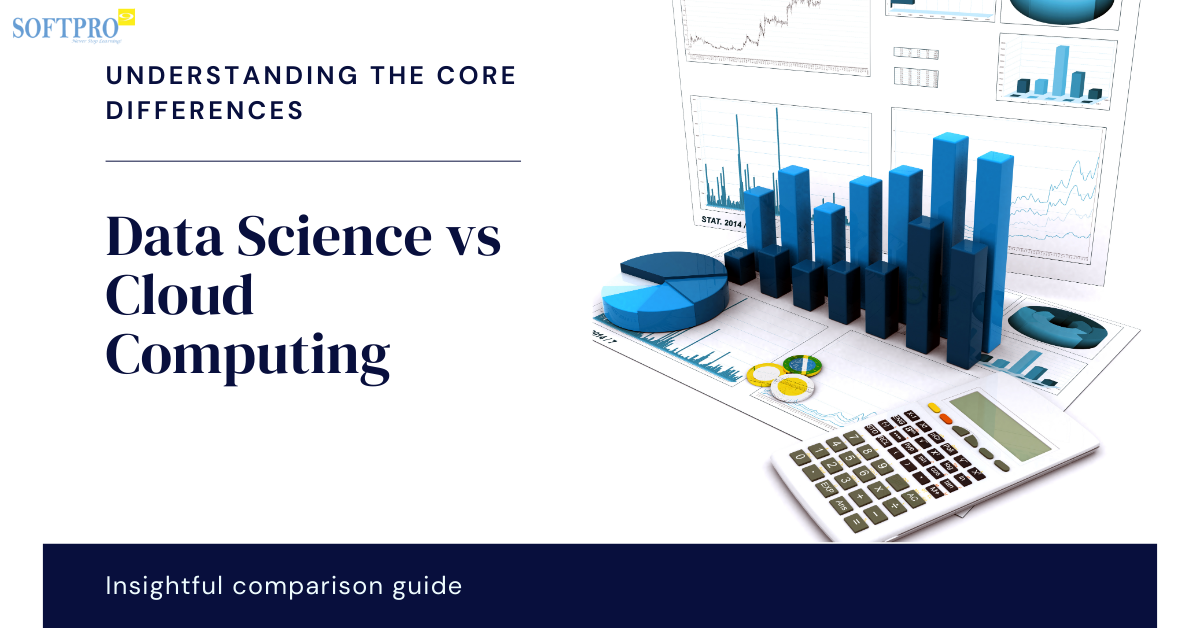
What is the Difference between Data Science and Cloud Computing
#1 Myinstitutes.com is one of the Best Educational Portal and Training Institutes in MYSORE, MANGALORE, and BANGALORE.
Data Science vs. Cloud Computing: A Comprehensive Overview
Both Data Science and cloud computing are at the forefront of modern technological advancements, driving innovations in industries ranging from healthcare and finance to e-commerce and entertainment. While they often work in tandem, they are distinct fields with their core principles, methodologies, and applications. Understanding the differences between data science and cloud computing can clarify their roles in an organization’s technological ecosystem.
1. Definition and Core Concepts
Data Science:
Data science is a multidisciplinary field that involves extracting meaningful insights, patterns, and knowledge from large amounts of data. It combines techniques from statistics, mathematics, computer science, and domain-specific expertise to analyze, interpret, and visualize data. The main goal of data science is to make informed decisions, optimize processes, and predict future trends based on data.
Key Components:
- Data Collection: Gathering raw data from various sources (databases, sensors, social media, etc.).
- Data Processing & Cleaning: Organizing, cleaning, and transforming data for analysis.
- Data Analysis: Employing statistical models, machine learning algorithms, and data mining techniques.
- Visualization: Presenting data-driven insights using charts, graphs, and dashboards.
- Prediction & Forecasting: Using models to forecast outcomes or trends.
- Programming Languages & Tools: Python, R, SQL, Jupyter Notebooks, TensorFlow, etc.
Cloud Computing:
Cloud computing refers to the on-demand availability of computing resources (such as storage, processing power, and networking) over the internet. Instead of owning and maintaining physical servers, organizations can rent resources from cloud providers, such as Amazon Web Services (AWS), Microsoft Azure, or Google Cloud Platform (GCP). Cloud computing provides flexibility, scalability, and cost-efficiency, making it a cornerstone for modern digital infrastructures.
Key Components:
- Infrastructure as a Service (IaaS): Provides virtualized computing resources like servers and storage.
- Platform as a Service (PaaS): Offers a platform for developers to build, test, and deploy applications.
- Software as a Service (SaaS): Delivers software applications over the internet on a subscription basis.
- Scalability: Easily scale resources up or down depending on demand.
- Global Accessibility: Resources and services are accessible from anywhere via the internet.
- Security and Reliability: Offers high availability, security measures, and disaster recovery capabilities.
2. Focus and Objectives
Data Science Focus:
The focus of data science is on data — extracting insights, building predictive models, and solving complex analytical problems. It addresses questions like:
- What patterns exist in the data?
- How can we predict future outcomes?
- How can we optimize a specific process or decision-making?
The outcome of data science is often used to influence business strategy, improve products, or guide operational changes.
Cloud Computing Focus:
Cloud computing focuses on infrastructure and services — delivering computational power, storage, and other IT resources on demand. It addresses challenges like:
- How can we efficiently store and manage massive datasets?
- How can we ensure that applications are highly available and scalable?
- How can organizations reduce the costs of IT infrastructure?
Cloud computing provides the backbone for many modern applications, enabling them to function globally, reliably, and at scale.
3. Key Differences
| Aspect | Data Science | Cloud Computing |
|---|---|---|
| Primary Purpose | To extract insights from data and support decision-making. | To provide scalable, on-demand IT resources over the internet. |
| Core Activities | Data analysis, model building, machine learning. | Managing computing infrastructure, deploying applications. |
| Key Technologies | Python, R, SQL, machine learning frameworks. | AWS, Azure, GCP, Kubernetes, virtual machines. |
| End Goal | Insights, forecasts, data-driven decisions. | Scalable, reliable infrastructure and computing power. |
| Data Involvement | Deep involvement in handling, analyzing, and interpreting data. | Primarily involved in storing and managing data. |
| Skills Required | Statistics, machine learning, data visualization. | Networking, system administration, cloud architecture. |
4. How They Intersect
Despite their differences, data science and cloud computing often work closely together in real-world applications:
- Data Storage and Processing: Cloud platforms offer scalable storage solutions (e.g., Amazon S3, Google Cloud Storage) that allow data scientists to store and manage vast datasets. This enables data scientists to access and process data without the limitations of local hardware.
- Compute Power for Analysis: Cloud computing provides the high computational power needed to run data science tasks, such as training machine learning models on large datasets or running complex simulations. Services like Amazon EC2 or Google Cloud Compute offer flexible compute resources that can be scaled based on demand.
- Machine Learning as a Service (MLaaS): Many cloud platforms provide ready-to-use machine learning tools and services. For example, AWS SageMaker, Google AI Platform, and Azure Machine Learning enable data scientists to build, train, and deploy models without worrying about the underlying infrastructure.
- Collaboration and Accessibility: Cloud-based platforms enable global collaboration on data science projects. Data scientists can share their work through cloud-based environments like Google Colab, Databricks, or JupyterHub hosted on the cloud, allowing teams to work simultaneously from different locations.
5. Use Cases in Industry
Data Science Use Cases:
- Healthcare: Predicting patient outcomes, personalized medicine, detecting anomalies in medical images.
- Finance: Fraud detection, risk management, stock market predictions.
- E-commerce: Recommendation systems, customer segmentation, price optimization.
Cloud Computing Use Cases:
- Startups & Enterprises: Hosting applications, managing databases, and running websites without needing physical servers.
- DevOps: Continuous integration and deployment (CI/CD) pipelines.
- Big Data Applications: Cloud infrastructure powers large-scale data pipelines for real-time data processing (e.g., streaming services like Netflix).
6. Skills and Career Paths
Data Scientist:
- Focus on data analysis, statistical modeling, machine learning.
- Tools: Python, R, TensorFlow, PyTorch, SQL.
- Key Skills: Analytical thinking, programming, statistics, machine learning, data wrangling.
Cloud Architect/Engineer:
- Focus on designing, deploying, and maintaining cloud infrastructure.
- Tools: AWS, Azure, Google Cloud, Kubernetes, Docker.
- Key Skills: Cloud architecture, networking, system administration, security, automation.
Conclusion:
Data science and cloud computing serve different, yet complementary purposes. Data science focuses on extracting insights from data, while cloud computing provides the scalable infrastructure to store and process that data. Together, they enable organizations to make data-driven decisions at scale, bringing significant value to businesses and end-users alike.



